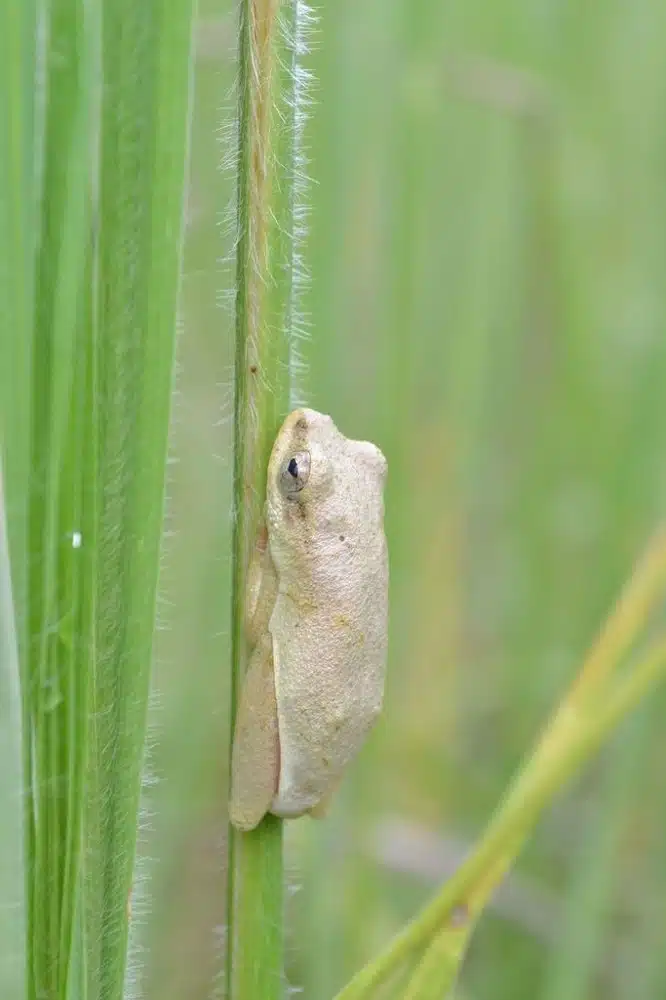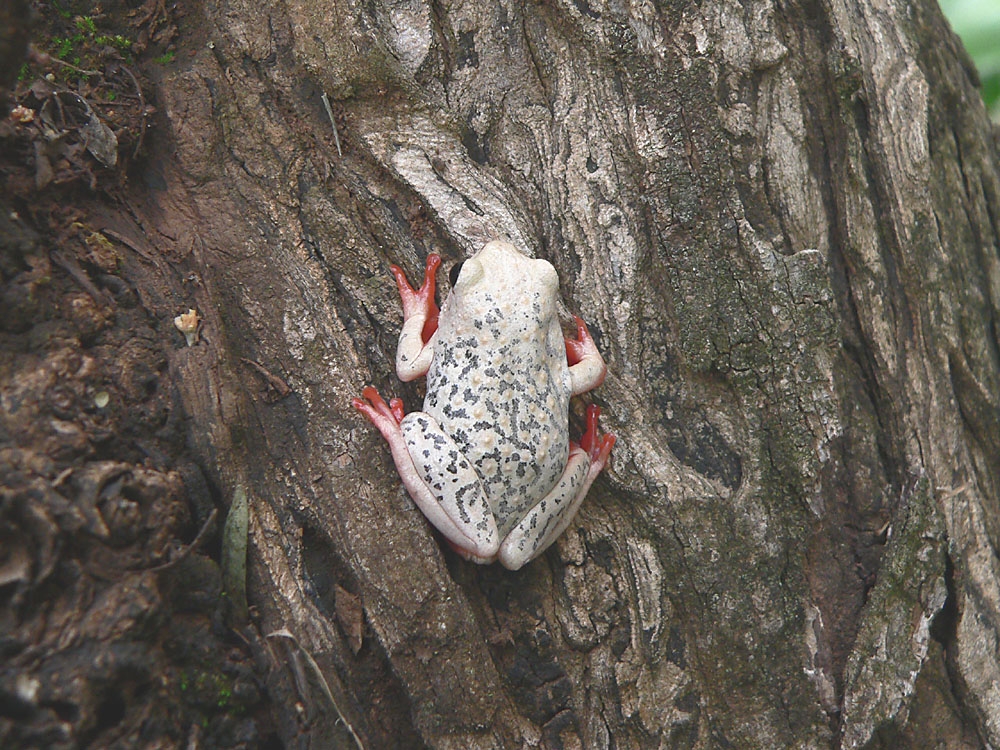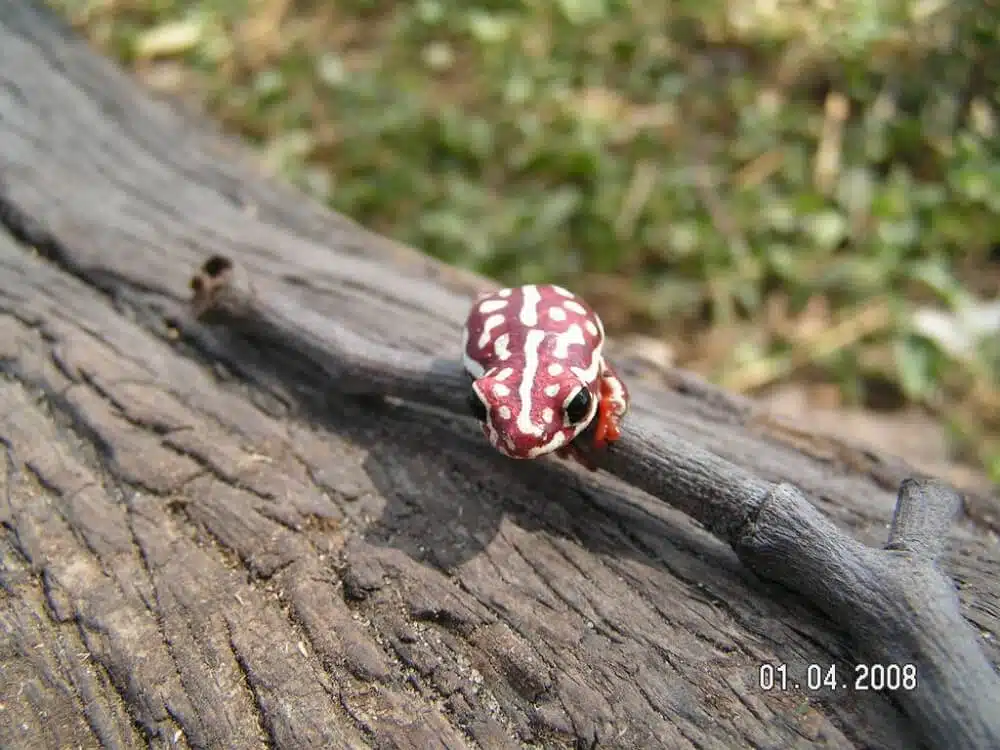While rare, white frogs are still represented by multiple species around the world. Many of these can change colors to become white.
Many white frogs are found in South America and Africa. Some species are also confirmed and established in The United States.
Most white frogs aren’t poisonous. However, those that are, might be so poisonous they can kill humans. Skin-level secretions can make their predators sick as well. The following common white frogs include poisonous species.
Table of Contents
1. Golden Poison Frog
Golden Poison Frogs (Phyllobates terribilis) are mostly known for their poison and colorful appearance. Green or yellow, Golden Poison Frogs are also white.
The white morph Golden Poison Frog may also show a few black spots across its body and legs.

This is a highly poisonous species that can even kill humans through skin secretions with batrachotoxins.
A species of the deep Amazon Rainforest, Golden Poison Frogs live in areas with very high yearly rainfall.
They inhabit areas of the forest next to water and are found at various low altitudes.
White frogs of the species have been collected for their poison by locals for hundreds of years although handling them isn’t recommended.
White color commonality – rare morph
2. Amazon Milk Frog

A species of The Amazon Rainforest, The Amazon Milk Frog (Trachycephalus resinifictrix) is named after the white skin secretion it releases when under threat.
This is a species that comes in pale blue coloring with black or brown patterns.
There’s also an off-white morph with brown patterns that isn’t uncommon at all.
As all morphs, this essentially white Amazon Milk Frog can be spotted on trees in some of the most humid areas of The Amazon.
Initially smooth, the frog eventually starts to show skin bumps or warts. These bumps aren’t visible in their first years but the species can still show them later on as it can live more than 15 years.
Amazon Milk Frogs might show skin secretions, but they aren’t poisonous. These are sticky secretions that make some predators vomit but the secretion cannot kill predators or humans.
White color commonality – morphs
3. Pacman Frog

Named after the beloved video game series, these types of frogs of South American origin also come in a white variant.
The frogs still have the characteristic large mouth that inspires the name of the species.
Available to purchase in different colors, Pacman frogs come in different variants such as Snow White, which are mostly white.
This variant is combined with pale pink dorsal patterns and it grows to a maximum size of about 4 inches.
When grown in captivity, the Snow White Pacman Frog is typically fed insects.
However, even in captivity, this is not the type of frog to live long.
It’s estimated Snow White may live up to 4 years, with many surviving just for a couple of years.
White color commonality – variant
4. Blue-back Reed Frog

Mostly white, the Blue-back Reed Frog (Heterixalus madagascariensis) is one of the common species in captivity due to its bright coloring.
This is a species with a flattened shape compared to Pacman Frogs that comes in a pearl white color.
Yellow interrupted stripes are seen along its body while small black dots then contrast its dorsum.
Another common morph of the species shows a completely white dorsum, with yellow and black patterns only distributed along its legs and mouth.
Blue-back Reed Frogs live in tropical forests. They can also live in these humid habitats for swamps and grasslands, but they are also seen within city limits.
White color commonality – mainly white
5. Dyeing Poison Frog

Dyeing Poison Frogs (Dendrobates tinctorius) are among the poisonous species of South America that also come on white.
These types of frogs are seen in Brazil, Guyanas, and in Suriname.
The white morph of Dyeing Poison Frogs is mostly found in Suriname. This is a mostly white morph with contrasting black patterns.
A similar white and black Dying Poison Frog also lives in Brazil, but it features blue legs.
In turn, the white and black morph in Suriname is mostly white. Even its legs are white, only contrasted by a few black dots.
A terrestrial species that likes relative and high humidity, this type of Suriname frog is tied to the rainforest.
It lives on the ground where its bright and contrasting appearance acts as a warning signal in front of potential predators.
While the species is poisonous, they are mostly identified by their bad taste.
Local animals eventually learn to stay away from these frogs mainly due to their taste before associating them with a poisonous or highly harmful species.
If consumed, this frog will eventually kill animals. It also produces and releases sufficient toxins to kill humans if ingested.
White color commonality – Suriname morph
6. Grey Foam-nest Tree Frog

Grey Foam-nest Tree Frogs (Chiromantis xerampelina) have an almost completely white appearance. More noticeably, these frogs have an off-white color.
They also come in various shades of gray, as their name implies. Green and brown morphs are also specific to this species.
Gray Foam-nest Tree Frogs are further known for being South African frogs that live in moist tropical woodlands as well as in more arid areas such as dry shrubland in tropical areas.
In fact, Gray Foam-nest Tree Frogs show an atypical resilience to survive long periods of drought.
A species found in multiple African countries, Grey Foam-nest Tree Frogs are supposedly now expanding into Australia.
This is a highly adaptable species even to the dry shrubland of Australia.
Grey Foam-nest Tree Frogs are arboreal frogs with adaptations that allow them to move up vertical surfaces.
Frogs of the species like trees so much that they even crawl under loose bark.
This is the first spot they seek shelter when it comes to surviving long periods of drought.
White color commonality – common morph
7. Painted Reed Frog

Also, an African species, Painted Reed Frogs (Hyperolius marmoratus) are among the multiple worldwide species that change colors at night.
These frogs may even show multiple colors during the day and during the night.
The frogs are known for their overall colorful nature, but they may also be almost completely white.
While not completely white, this frog barely shows patterns or dots. Brown or black dots are mostly specific to its dorsum, but only its white morph.
Furthermore, the period of the day when the Painted Reed Frog is white is also the period this species is mostly seen with tiny black dots.
In this morph, its extremities might also be red.
Apart from the white period, the frog also goes through periods where dark nuance colors dominate its appearance.
Yellow and black, green, and brown colors are specific to the frog on most days.
The species may even take on the colors of the vegetation it rests on during the day.
White color commonality – a brief daily occurrence
8. Chalky Reed Frog

An African species, Chalky Reed Frog (Hyperolius nitidulus) is found next to water sources in multiple countries, including Nigeria.
This is a frog that changes colors depending on the season, weather, and even daytime.
One color can be specific during the day while the frog can change to another color during the night.
Most importantly, Chalky Reed Frogs take on a white color during the hottest months of the year.
This is when they even rely on the white color to reflect the rays of the sun, keeping them cooler and avoiding complete dehydration.
Chalky Reed Frogs are so good in this process that they don’t even hide as they expose themselves in full sun, typically on a leaf.
They remain motionless for months in a row, until the warmest period of the year passes.
This is a time when the frog doesn’t move at all. It can simply be seen as a white lump, with its tucked legs.
Frogs don’t drink or eat during this period and they might not even leave the leaf they’re resting on if not chased by a predator.
Their white colors and their motionless state during these months typically attract little to no attention as they’re overlooked by predators.
White color commonality – dry season only
9. Common Reed Frog

Common Reed Frogs (Hyperolius viridiflavus) are also found in Africa. They have an expansive habitat throughout the Central African countries.
Much of the lives of these frogs are marked by color changes.
Juveniles are dark as they become adults and they may even show color changes depending on seasons or the time of the day.
A typical diurnal frog, Common Reed Frogs become inactive during the hottest months of the year.
The young frogs of the species take on a white color from their purine crystals in the skin.
It’s these crystals that help the species reflect the rays of the sun and avoid dehydration as the frog remains motionless for the hottest months of the year.
Once an adult, the frog can take on different colors such as black and orange.
These frogs are found around different lakes and rivers. They have also adapted to living on farms, marshes, and in other areas next to water.
White color commonality – dry season juvenile
10. Angolan Reed Frog

The Angolan Reed Frog (Hyperolius parallelus) is one of the Central-African species that are both white or partially white and abundant.
Frogs of the species show varying patterns and the capacity to change and adapt colors with the seasons.
Multiple white morphs are noted for these frogs.
A common morph shows a base white Angolan Reed Frog with brown-red spots across its dorsum.
Another white morph shows mottled black patterns across the dorsum.
A third white morph shows a mostly white frog with lateral yellow and red stripes.
Other morphs show a mostly red, brown, green, or orange Angolan Reed Frog with white patterns across the dorsum and a white underbelly.
All of these colors are influenced by the age of the frog, apart from the season and its most common environment.
White color commonality – multiple white morphs
11. Margined Reed Frog

Margined Reed Frogs (Hyperolius marginatus) have very particular environmental preferences and come in different colors, including white variants.
Some of its most common variants include a white-pink morph, a white morph with dark green patterns as well as orange-brown morphs with black patterns.
Common in African countries such as Tanzania and Congo, this species is known to prefer humid habitats, but only in places with new vegetation where it faces a reduced number of predators.
Swamps around savannas are among the temporary or permanent places the species inhabits.
White color commonality – multiple white morphs
12. Cuban Tree Frog

Often wrongly believed to be poisonous, Cuban Tree Frogs (Osteopilus septentrionalis) are among the species moving into the US through Florida, which are white.
The frog itself is not always white. In fact, Cuban Tree Frogs can change colors to blend in.
Its white color is seen when the species lives in a bright environment, such as on rocky terrains.
Off-white variants are also specific to Cuban Tree Frogs on bright tree bark, as the species is arboreal.
White color commonality – only white when it changes color